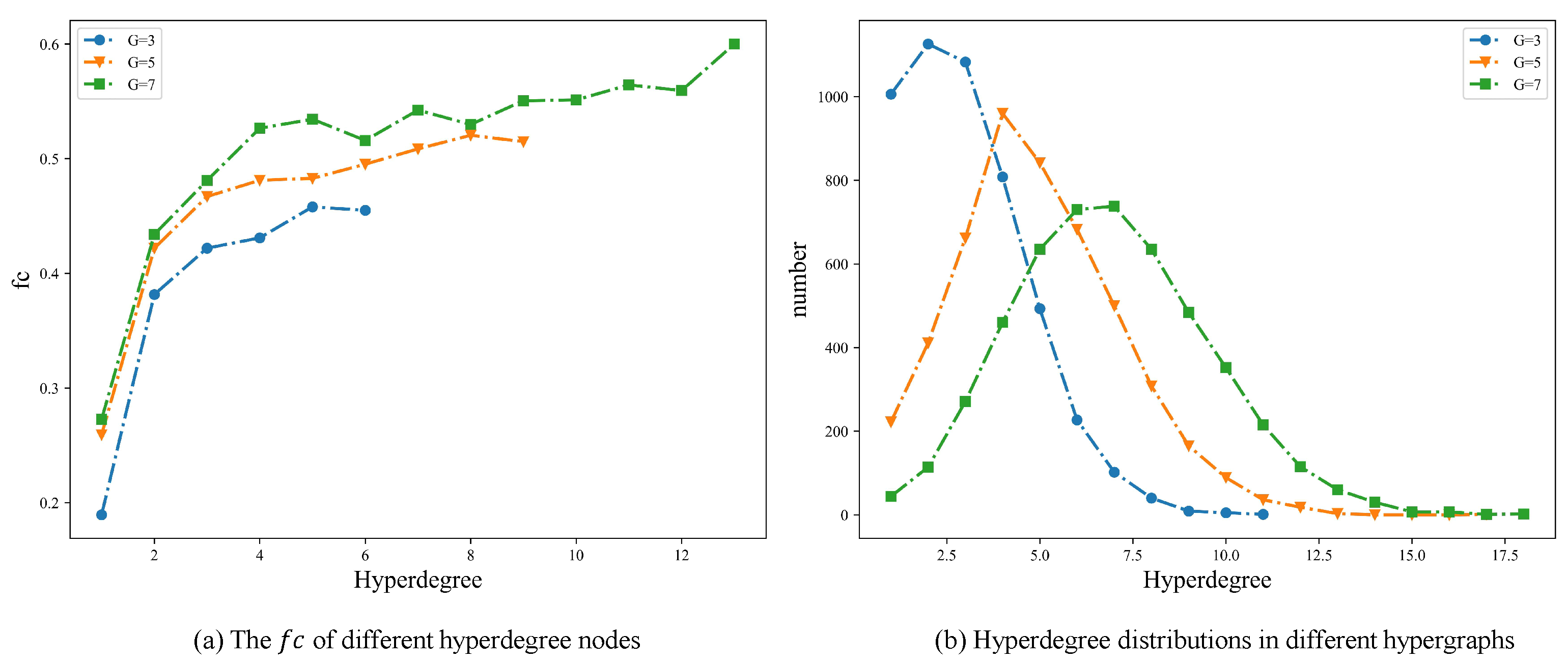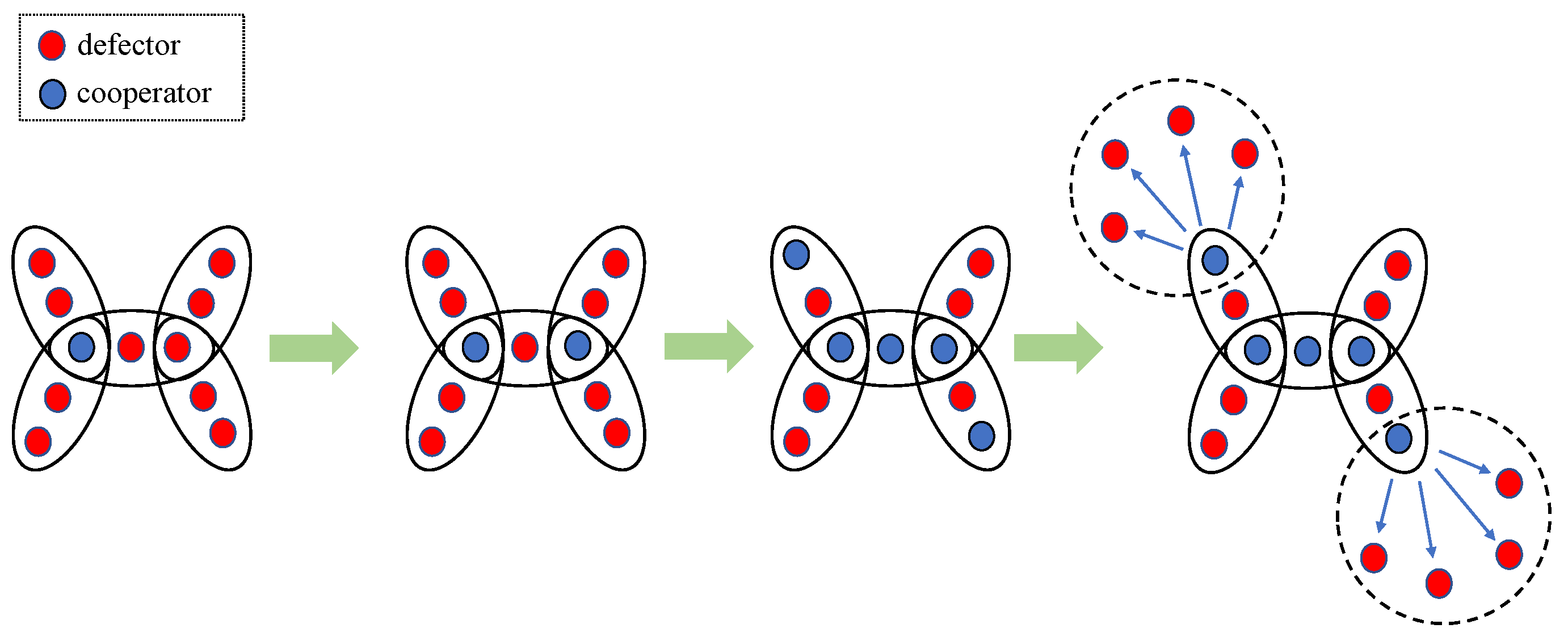The Evolution of Cooperation in Multigames with Uniform Random Hypergraphs
Abstract
1. Introduction
2. Model
2.1. Hypergraph Structure
2.2. Evolutionary Multigames
| Algorithm 1 Monte Carlo simulation |
 |
3. Results and Discussion
3.1. The Impact of Multigame Matrix Differences on the Evolution of Cooperation in Hypergraphs
3.2. The Impact of Network Structure on the Evolution of Cooperation in Hypergraphs
3.2.1. The Influence of G and L on the Fraction of Cooperators
3.2.2. Exploring the Impact of Hyperdegree on the Evolution of Cooperation
3.2.3. Microcosmic Analysis of Node Evolution with Varied Hyperdegrees
4. Conclusions
Author Contributions
Funding
Data Availability Statement
Conflicts of Interest
References
- Axelrod, R.; Hamilton, W.D. The evolution of cooperation. Science 1981, 211, 1390–1396. [Google Scholar] [CrossRef] [PubMed]
- Perc, M.; Jordan, J.J.; Rand, D.G.; Wang, Z.; Boccaletti, S.; Szolnoki, A. Statistical physics of human cooperation. Phys. Rep. 2017, 687, 1–51. [Google Scholar] [CrossRef]
- Roca, C.P.; Cuesta, J.A.; Sánchez, A. Evolutionary game theory: Temporal and spatial effects beyond replicator dynamics. Phys. Life Rev. 2009, 6, 208–249. [Google Scholar] [CrossRef]
- Santos, F.C.; Santos, M.D.; Pacheco, J.M. Social diversity promotes the emergence of cooperation in public goods games. Nature 2008, 454, 213–216. [Google Scholar] [CrossRef] [PubMed]
- Traulsen, A.; Reed, F.A. From genes to games: Cooperation and cyclic dominance in meiotic drive. J. Theor. Biol. 2012, 299, 120–125. [Google Scholar] [CrossRef] [PubMed]
- Henrich, J.; Boyd, R.; Bowles, S.; Camerer, C.; Fehr, E.; Gintis, H.; McElreath, R. In search of homo economicus: Behavioral experiments in 15 small-scale societies. Am. Econ. Rev. 2001, 91, 73–78. [Google Scholar] [CrossRef]
- Smith, J.M.; Price, G.R. The logic of animal conflict. Nature 1973, 246, 15–18. [Google Scholar] [CrossRef]
- Weibull, J.W. Evolutionary Game Theory; MIT Press: Cambridge, MA, USA, 1997. [Google Scholar]
- Hofbauer, J.; Sigmund, K. Evolutionary Games and Population Dynamics; Cambridge University Press: Cambridge, UK, 1998. [Google Scholar]
- Liu, D.; Huang, C.; Dai, Q.; Li, H. Positive correlation between strategy persistence and teaching ability promotes cooperation in evolutionary prisoner’s dilemma games. Phys. A Stat. Mech. Appl. 2019, 520, 267–274. [Google Scholar] [CrossRef]
- Szolnoki, A.; Perc, M. Coevolution of teaching activity promotes cooperation. New J. Phys. 2008, 10, 043036. [Google Scholar] [CrossRef]
- Shu, F.; Liu, X.; Fang, K.; Chen, H. Memory-based snowdrift game on a square lattice. Phys. A Stat. Mech. Appl. 2018, 496, 15–26. [Google Scholar] [CrossRef]
- Shu, F.; Liu, Y.; Liu, X.; Zhou, X. Memory-based conformity enhances cooperation in social dilemmas. Appl. Math. Comput. 2019, 346, 480–490. [Google Scholar] [CrossRef]
- Shu, F.; Liu, X.; Li, M. Impacts of memory on a regular lattice for different population sizes with asynchronous update in spatial snowdrift game. Phys. Lett. A 2018, 382, 1317–1323. [Google Scholar] [CrossRef]
- Yang, H.X.; Yang, J. Reputation-based investment strategy promotes cooperation in public goods games. Phys. A Stat. Mech. Appl. 2019, 523, 886–893. [Google Scholar] [CrossRef]
- Wang, L.; Chen, T.; Wu, Z. Promoting cooperation by reputation scoring mechanism based on historical donations in public goods game. Appl. Math. Comput. 2021, 390, 125605. [Google Scholar] [CrossRef]
- Fu, M.; Guo, W.; Cheng, L.; Huang, S.; Chen, D. History loyalty-based reward promotes cooperation in the spatial public goods game. Phys. A Stat. Mech. Appl. 2019, 525, 1323–1329. [Google Scholar] [CrossRef]
- Fu, M.; Wang, J.; Cheng, L.; Chen, L. Promotion of cooperation with loyalty-based reward in the spatial prisoner’s dilemma game. Phys. A Stat. Mech. Appl. 2021, 580, 125672. [Google Scholar] [CrossRef]
- Quan, J.; Pu, Z.; Wang, X. Comparison of social exclusion and punishment in promoting cooperation: Who should play the leading role? Chaos Solit. Fractals 2021, 151, 111229. [Google Scholar] [CrossRef]
- Wang, Q.; Meng, H.; Gao, B. Spontaneous punishment promotes cooperation in public good game. Chaos Solit. Fractals 2019, 120, 183–187. [Google Scholar] [CrossRef]
- Wang, Z.; Szolnoki, A.; Perc, M. Different perceptions of social dilemmas: Evolutionary multigames in structured populations. Phys. Rev. E 2014, 90, 032813. [Google Scholar] [CrossRef]
- Chowdhury, S.N.; Kundu, S.; Perc, M.; Ghosh, D. Complex evolutionary dynamics due to punishment and free space in ecological multigames. Proc. R. Soc. A 2021, 477, 20210397. [Google Scholar] [CrossRef]
- Deng, Z.H.; Huang, Y.J.; Gu, Z.Y.; Liu, D.; Gao, L. Multi-games on interdependent networks and the evolution of cooperation. Phys. A Stat. Mech. Appl. 2018, 510, 83–90. [Google Scholar] [CrossRef]
- Liu, Y.; Li, Z.; Jin, X.; Tao, Y.; Ding, H.; Wang, Z. The effect of perceptions competition and learning costs on cooperation in spatial evolutionary multigames. Chaos Solit. Fractals 2022, 157, 111883. [Google Scholar] [CrossRef]
- Liu, C.; Guo, H.; Li, Z.; Gao, X.; Li, S. Coevolution of multi-game resolves social dilemma in network population. Appl. Math. Comput. 2019, 341, 402–407. [Google Scholar] [CrossRef]
- Roy, S.; Nag Chowdhury, S.; Mali, P.C.; Perc, M.; Ghosh, D. Eco-evolutionary dynamics of multigames with mutations. PLoS ONE 2022, 17, e0272719. [Google Scholar] [CrossRef]
- Huang, Y.J.; Deng, Z.H.; Song, Q.; Wu, T.; Deng, Z.L.; Gao, M.y. The evolution of cooperation in multi-games with aspiration-driven updating rule. Chaos Solit. Fractals 2019, 128, 313–317. [Google Scholar] [CrossRef]
- Amaral, M.A.; Javarone, M.A. Heterogeneity in evolutionary games: An analysis of the risk perception. Proc. R. Soc. A 2020, 476, 20200116. [Google Scholar] [CrossRef]
- Amaral, M.A.; Wardil, L.; Perc, M.; da Silva, J.K. Evolutionary mixed games in structured populations: Cooperation and the benefits of heterogeneity. Phys. Rev. E 2016, 93, 042304. [Google Scholar] [CrossRef]
- Wu, Y.; Zhang, Z.; Wang, X.; Yan, M.; Zhang, Q.; Zhang, S. Evolution of cooperation in the multigame on a two-layer square network. Appl. Math. Comput. 2021, 400, 126088. [Google Scholar] [CrossRef]
- Lin, Z.; Xu, H.; Fan, S. Evolutionary accumulated temptation game on small world networks. Phys. A Stat. Mech. Appl. 2020, 553, 124665. [Google Scholar] [CrossRef]
- Wang, C. Opinion Dynamics with Higher-Order Bounded Confidence. Entropy 2022, 24, 1300. [Google Scholar] [CrossRef]
- Gibbs, T.; Levin, S.A.; Levine, J.M. Coexistence in diverse communities with higher-order interactions. Proc. Natl. Acad. Sci. USA 2022, 119, e2205063119. [Google Scholar] [CrossRef] [PubMed]
- Li, Y.; Cheng, M.; Fujii, K.; Hsieh, F.; Hsieh, C.J. Learning from group comparisons: Exploiting higher order interactions. Adv. Neural Inf. Process. Syst. 2018, 31, 4981–4990. [Google Scholar]
- Battiston, F.; Cencetti, G.; Iacopini, I.; Latora, V.; Lucas, M.; Patania, A.; Young, J.G.; Petri, G. Networks beyond pairwise interactions: Structure and dynamics. Phys. Rep. 2020, 874, 1–92. [Google Scholar] [CrossRef]
- Gao, Z.; Ghosh, D.; Harrington, H.; Restrepo, J.; Taylor, D. Dynamics on networks with higher-order interactions. Chaos Interdiscip. J. Nonlinear Sci. 2023, 33, 040401. [Google Scholar] [CrossRef] [PubMed]
- Alvarez-Rodriguez, U.; Battiston, F.; de Arruda, G.F.; Moreno, Y.; Perc, M.; Latora, V. Evolutionary dynamics of higher-order interactions in social networks. Nat. Hum. Behav. 2021, 5, 586–595. [Google Scholar] [CrossRef] [PubMed]
- Alvarez-Rodriguez, U.; Battiston, F.; Ferraz de Arruda, G.; Moreno, Y.; Perc, M.; Latora, V. Collective Games on Hypergraphs. In Higher-Order Systems; Springer: Cham, Switzerland, 2022; pp. 377–388. [Google Scholar]
- Szabó, G.; Toke, C. Evolutionary prisoner’s dilemma game on a square lattice. Phys. Rev. E 1998, 58, 69. [Google Scholar] [CrossRef]
- Berge, C. Hypergraphs: Combinatorics of Finite Sets; Elsevier: Amsterdam, The Netherlands, 1984; pp. 1–39. [Google Scholar]
- Wang, Z.; Li, R.; Jin, X.; Ding, H. Emergence of Social Norms in Metanorms Game with High-Order Interaction Topology. IEEE Trans. Comput. Soc. Syst. 2022; in press. [Google Scholar] [CrossRef]
- Szabó, G.; Szolnoki, A. Cooperation in spatial prisoner’s dilemma with two types of players for increasing number of neighbors. Phys. Rev. E 2009, 79, 016106. [Google Scholar] [CrossRef]







Disclaimer/Publisher’s Note: The statements, opinions and data contained in all publications are solely those of the individual author(s) and contributor(s) and not of MDPI and/or the editor(s). MDPI and/or the editor(s) disclaim responsibility for any injury to people or property resulting from any ideas, methods, instructions or products referred to in the content. |
© 2023 by the authors. Licensee MDPI, Basel, Switzerland. This article is an open access article distributed under the terms and conditions of the Creative Commons Attribution (CC BY) license (https://creativecommons.org/licenses/by/4.0/).
Share and Cite
Xu, H.; Zhang, Y.; Jin, X.; Wang, J.; Wang, Z. The Evolution of Cooperation in Multigames with Uniform Random Hypergraphs. Mathematics 2023, 11, 2409. https://doi.org/10.3390/math11112409
Xu H, Zhang Y, Jin X, Wang J, Wang Z. The Evolution of Cooperation in Multigames with Uniform Random Hypergraphs. Mathematics. 2023; 11(11):2409. https://doi.org/10.3390/math11112409
Chicago/Turabian StyleXu, Haozheng, Yiwen Zhang, Xing Jin, Jingrui Wang, and Zhen Wang. 2023. "The Evolution of Cooperation in Multigames with Uniform Random Hypergraphs" Mathematics 11, no. 11: 2409. https://doi.org/10.3390/math11112409
APA StyleXu, H., Zhang, Y., Jin, X., Wang, J., & Wang, Z. (2023). The Evolution of Cooperation in Multigames with Uniform Random Hypergraphs. Mathematics, 11(11), 2409. https://doi.org/10.3390/math11112409




